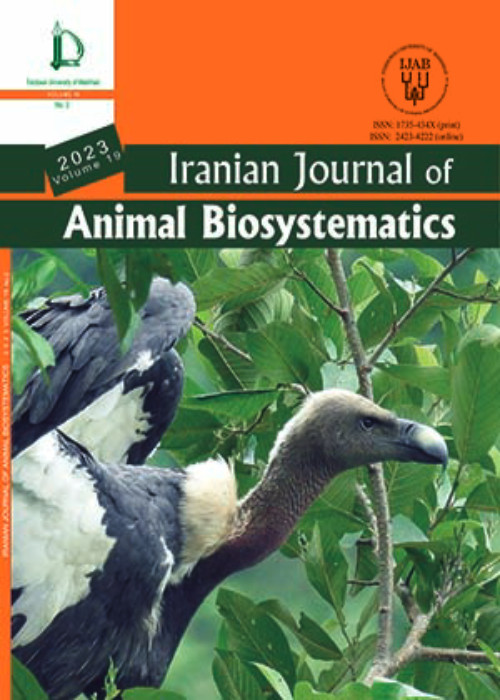فهرست مطالب
Iranian journal of animal biosystematics
Volume:9 Issue: 2, Summer-Autumn 2013
- تاریخ انتشار: 1392/09/07
- تعداد عناوین: 7
-
-
Page 91Six species of the genus Elasmus Westwood (Hymenoptera: Chalcidoidea: Eulophidae) were reported from Southeastern Iran. Five species viz., Elasmus indicus Rohwer, 1921, Elasmus johnstoni Ferrière, 1929, Elasmus nephantidis Rohwer, 1921, Elasmus phthorimaeae Ferrière 1947, Elasmus viridiceps Thomson, 1878, are recorded for the first time from Iran. Elasmus nudus (Nees, 1834) is already recorded from this country. Available biological data, geographical distribution as well as short taxonomic comments are given for each species. A key for identification of Iranian species of the genus Elasmus is presented.Keywords: Hymenoptera, Eulophidae, Elasmus, distribution, new records, Iran
-
Page 99The hermit crab fauna of the Larak Island was investigated, which revealed seven species representing five genera and two families. The family Diogenidae represents six species namely Areopaguristes perspicax (Nobili, 1906), Clibanarius signatus Heller, 1861, Dardanus lagopodes (Forskål, 1775), D. tinctor (Forskål, 1775), D. avarus Heller, 1865, D. tirmiziae Siddiqui & McLaughlin, 2003, while the family Coenobitidae represents only one species, Coenobita scaevola (Forskål, 1775). Besides, information on habitat preferences, geographical distribution and the dominant occupied shells has also been covered.Keywords: Paguroidea, Persian Gulf, Diogenidae, Intertidal, Larak Island
-
Redescription of Annina mesopotamica Ahmed, 1971 (Crustacea, Cirolanidae, Isopoda) from Basrah, IraqPage 109Annina mesopotamica (Ahmed, 1971), from Iraq (Shat-Al-Arab River bank, Basrah) is redescribed. A. mesopotamica can be distinguished from other species of the genus in having a pair of short and blunt dorso-lateral horns on the male pereonite 2. A revised generic diagnosis is provided for the genus Annina.Keywords: redescription, Isopoda, Cirolanidae, Annina mesopotamica
-
Page 117New faunistic records for 15 species of Salticidae for the spider fauna of Iran are presented. Five species (Langona aperta, Mogrus antonius, Pellenes bonus, P. geniculatus and Sitticus karakumensis) are new records for the spider fauna of Iran.Keywords: Salticidae, Iran, faunistics, new records, distribution
-
Page 125We collected 60 adult males and 85 adult females of Trapelus lessonae De Filippi, 1863 in early May 2008 from central Iranian plateau to study sexual dimorphism in morphological traits as well as female reproductive traits. Size-related sexual dimorphism occurred in all the compared body dimensions. The largest female was 83.88 mm in snout-vent length, and the largest male was 73.12 mm. As well, adult males were larger in head size and tail length, whereas females were larger in body size and abdomen length. Males and females also presented differences in color pattern, and in the presence of preanal pores. The results suggest that, in Trapelus lessonae, sexual dimorphism in size is determined by sexual selection, competition between males and fecundity selection, fecundity advantage for large female size. A pattern generated by fecundity advantages enjoyed by large females.Keywords: Agamidae, Trapelus lessonae, Sexual dimorphism, Sexual selection, Fecundity selection, Iranian Plateau
-
Page 135In order to study the ecology of the genius Microtus Schrank, 1798 (Mammalia: Rodentia) in NWof Iran, three regions including Salmas, Marand, and Moghan were selected. The number of active nests of M. socialis and M. aff. socialis (2n=54) were detected during spring and autumn. In this period, detection were made in three blocks of each location (each one 20×50m) with intervals of one week in 2008-2009. In each blocks, hole colony diameter, slop, length, distance from the other holes, number of rooms in the holes, shape of the tunnels and their connection to each other were measured in the block from the same colony. Meteorological data of each location including temperature (ºC), humidity (%) and rainfall (mm) were obtained from meteorological stations. Decrease in population was found in the first and second blocks of Salmas from 2008 autumn to 2009, but an increase in population was observed after 2009 autumn to September 2010. In spite of appropriate weather conditions, it is agricultural controls that have probably caused changes in population size. The number of M. socialis nesting population in Moghan was higher than Salmas and Marand. The average sizes of diameter and length of the holes were 47.7 mm and 510 mm, and the slope angle was 35.4° in Marand. In Salmas, the average for diameter, length of hole entry, and slope angle degrees were 43 mm, 498 mm and 29.5° respectively. In Moghan, both types of the described colonies were observed.Keywords: Iran, Microtus, ecology, nesting population
-
Page 147The Indian Garden lizard has been recorded as herpetofauna of Iran but the only existing records belong to far years before in which Balnford (1870) and Zarudny (1903) recorded 2-3 specimens in Sistan and Baluchestan province of Iran. Afterward, there were no records on the species in the country. Based on the existing records the mentioned localities were investigated for years and using the information gained from local people finally we could find two specimens in Geravani village in Saravn city area, one adult and the other a juvenile. The captured adult had snout- vent length of 121.7 mm and tail length of 293.2 mm. The main color of the adult one was light brown to gray with patches of dark brown and white. Red throat and orange shoulders and orbit area were the main colorful parts. Other parts are under investigation to find more specimens.Keywords: Indian Garden Lizard, Calotes versicolor, Agamidae, new record, Iran


